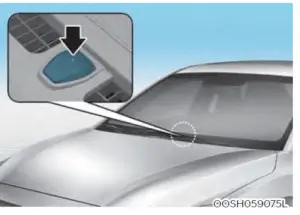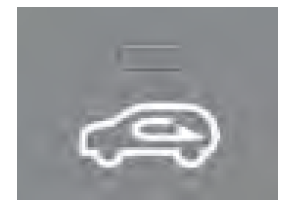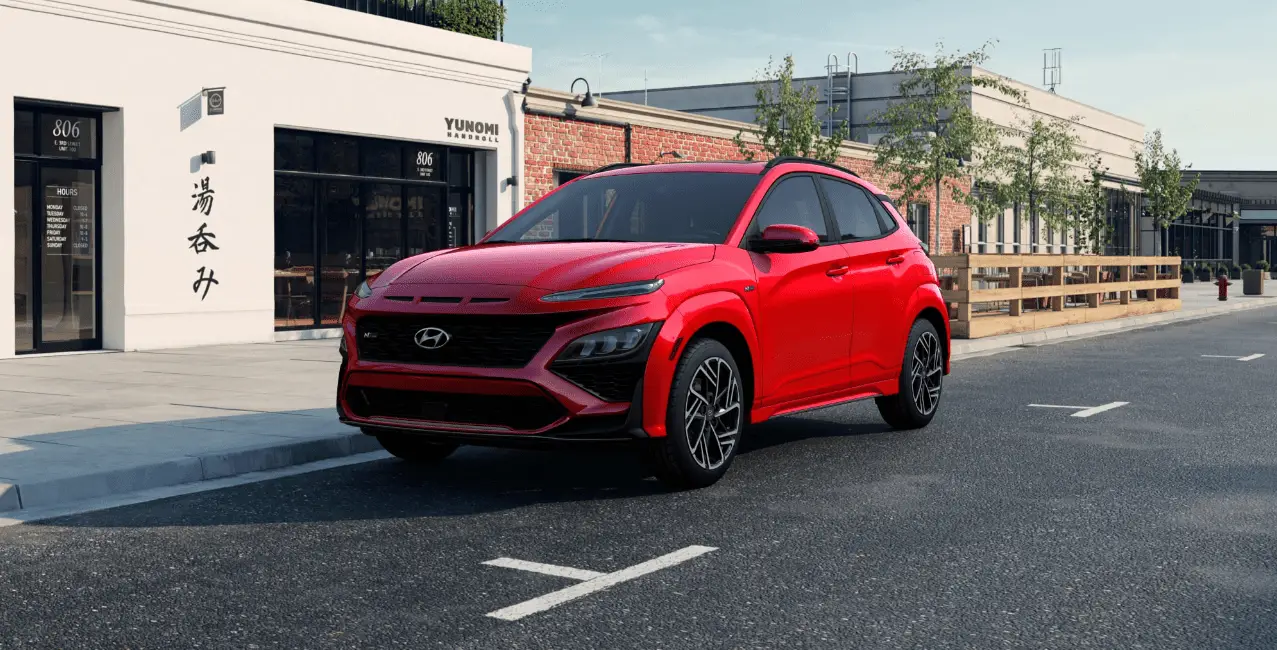Hyundai Kona 2023 Automatic Climate Control System
A smart and intuitive climate control system that epitomizes comfort and convenience is introduced in the 2023 Hyundai Kona Automatic Climate Guidelines. Drivers can easily keep the temperature they choose in the cabin with Automatic Climate Control, which lets the system adjust the airflow and temperature to create the ideal atmosphere. These recommendations place a strong emphasis on simplicity of use, allowing residents to benefit from a stable and cozy temperature without having to make frequent manual adjustments. The Automatic Climate Control technology in the 2023 Kona offers a smooth and hassle-free approach to interior comfort, boosting the entire driving experience. This is a tribute to Hyundai’s commitment to modern and enjoyable driving experiences.
2023 Hyundai KONA Specs, Price, Features, Milage (Brochure)
Automatic Climate Control System

- Temperature control knob
- Fan speed control knob
- AUTO (automatic control) button
- Air conditioning button
- OFF button
- Front windshield defroster button
- Mode selection button
- Rear window defroster button
- Air intake control button
- Climate control information screen
Automatic Heating and Air Conditioning
The Automatic Climate Control System is controlled by setting the desired temperature.
- Press the AUTO button. (3) The modes, fan speeds, air intake and air-conditioning will be controlled automatically by the temperature setting you select.
- Turn the temperature control knob (1) to the desired temperature. If the temperature is set to the lowest setting (Lo), the air conditioning system will operate continuously. After the interior has cooled sufficiently, adjust the knob to a higher temperature set point whenever possible.
To turn the automatic operation off, select any button of the following:
- Mode selection button
- Front windshield defroster button (Press the button one more time to deselect the front windshield defroster function. The ‘AUTO’ sign will illuminate on the information display once again.)
- Fan speed control button
The selected function will be controlled manually while other functions operate automatically.
For your convenience and to improve the effectiveness of the climate control, use the AUTO button and set the temperature to 72°F (22°C).

Information
Never place anything near the sensor to ensure better control of the heating and cooling system.
Manual Heating and Air Conditioning
The heating and cooling system can be controlled manually by pushing buttons other than the AUTO button. In this case, the system works sequentially according to the order of buttons selected. When pressing any button except the AUTO button while using automatic operation, the functions not selected will be controlled automatically.
- Start the engine.
- Set the mode to the desired position. For improving the effectiveness of heating and cooling, select:
- Heating:
- Cooling:
- Set the temperature control to the desired position.
- Set the air intake control to the outside (fresh) air position.
- Set the fan speed control to the desired speed.
- If air conditioning is desired, turn the air conditioning system on.
- Press the AUTO button to convert to full automatic control of the system.
Mode selection

The mode selection button controls the direction of the air flow through the ventilation system.
Defrost-Level (A, D)
Most of the air flow is directed to the windshield.
Face-Level (B, D)
Air flow is directed toward the upper body and face. Additionally, each outlet can be controlled to direct the air discharged from the outlet.
Floor-Level (A, C, D, E)
Most of the air flow is directed to the floor.
Defrost-Level (A) (6)
Most of the air flow is directed to the windshield with a small amount of air directed to the side window defrosters.

Instrument panel vents
The outlet vents can be opened or closed ( ) separately using the thumbwheel. Also, you can adjust the direction of air delivery from these vents using the vent control lever as shown.
Temperature control (1)
The temperature will increase by turning the knob to the right. The temperature will decrease by turning the knob to the left.
Air intake control (9)
This is used to select the outside (fresh) air position or recirculated air position. To change the air intake control position, push the control button.
Recirculated air position

With the recirculated air position selected, air from the passenger compartment will be drawn through the heating system and heated or cooled according to the function selected.
Outside (fresh) air position


With the outside (fresh) air position selected, air enters the vehicle from outside and is heated or cooled according to the function selected.
Information
Using the system in the fresh air position is recommended. Prolonged operation of the heater in the recirculated air position (without air conditioning selected) can cause fogging of the windshield and side windows and the air within the passenger compartment will become stale. In addition, prolonged use of the air conditioning with the recirculated air position selected will result in excessively dry air in the passenger compartment.
WARNING
Continued climate control system operation in the recirculated air position may allow humidity to increase inside the vehicle which may fog the glass and obscure visibility. Do not sleep in a vehicle with the air conditioning or heating system on. It may cause serious harm or death due to a drop in the oxygen level and/or body temperature. Continued climate control system operation in the recirculated air position can cause drowsiness or sleepiness, and loss of vehicle control. Set the air intake control to the outside (fresh) air position as much as possible while driving.
Fan speed control (2)
The fan speed can be set as desired by turning the fan speed control knob. More air is delivered with higher fan speeds. Pressing the OFF button turns off the fan.
NOTICE
For better sound quality, fan speed may automatically slow down for a couple of minutes when you activate voice recognition or hands free.
Air conditioning (4)
Push the A/C button to manually turn the system on (indicator light will illuminate) and off.
OFF mode (5)
Push the OFF button to turn the climate control system off. You can still operate the mode and air intake buttons as long as the ignition switch is in the ON position.
System Operation
Ventilation
- Set the mode to the position.
- Set the air intake control to the outside (fresh) air position.
- Set the temperature control to the desired position.
- Set the fan speed control to the desired speed.
Heating
- Set the mode to the position.
- Set the air intake control to the outside (fresh) air position.
- Set the temperature control to the desired position.
- Set the fan speed control to the desired speed.
- If dehumidified heating is desired, turn the air conditioning system on.
- If the windshield fogs up, set the mode to the or position.
Operation Tips
To help keep dust or unpleasant fumes from entering the vehicle through the ventilation system, temporarily set the air intake control to the recirculated air position. Be sure to return the control to the fresh air position when the irritation has passed to keep fresh air in the vehicle. This will help keep the driver alert and comfortable. To prevent interior fog on the windshield, set the air intake control to the fresh air position and fan speed to the desired position, turn on the air conditioning system, and adjust the temperature control to the desired temperature. windshield, set the air intake control to the fresh air position and fan speed to the desired position, turn on the air conditioning system, and adjust the temperature control to the desired temperature.
- Start the engine. Push the air conditioning button.
- Set the mode to the position.
- Set the air intake control to the outside air or recirculated air position.
- Adjust the fan speed control and temperature control to maintain maximum comfort.
NOTICE
When using the air conditioning system, monitor the temperature gauge closely while driving up hills or in heavy traffic when outside temperatures are high. Air conditioning system operation may cause engine overheating. Continue to use the fan but turn the air conditioning system off if the temperature gauge indicates engine overheating.
Air conditioning system operation tips
If the vehicle has been parked in direct sunlight during hot weather, open the windows for a short time to let the hot air inside the vehicle escape. After sufficient cooling has been achieved, switch back from the recirculated air to the fresh outside air position. To help reduce moisture inside of the windows on rainy or humid days, decrease the humidity inside the vehicle by operating the air conditioning system with the windows and sunroof closed. Use the air conditioning system every month for a few minutes to ensure maximum system performance. If you operate the air conditioner excessively, the difference between the temperature of the outside air and that of the windshield could cause the outer surface of the windshield to fog up, causing loss of visibility. In this case, set the mode selection button to the position and set the fan speed control knob to the lowest speed setting.
System Maintenance
Cabin air filter

- Outside air,
- Recirculated air
- Cabin air filter,
- Blower
- Evaporator core,
- Heater core
The cabin air filter is installed behind the glove box. It filters the dust or other pollutants that enter the vehicle through the heating and air conditioning system. Have the cabin air filter be replaced by an authorized HYUNDAI dealer according to the maintenance schedule. If the vehicle is being driven in severe conditions such as dusty or rough roads, more frequent climate control filter inspections and changes are required. If the air flow rate suddenly decreases, have the system checked at an authorized HYUNDAI dealer.
Checking the amount of air conditioner refrigerant and compressor lubricant
When the amount of refrigerant is low, the performance of the air conditioning is reduced. Overfilling also reduces the performance of the air conditioning system. Therefore, if abnormal operation is found, have the system inspected by an authorized HYUNDAI dealer.
NOTICE
It is important that the correct type and amount of oil and refrigerant is used. Otherwise, damage to the compressor and abnormal system operation may occur. To prevent damage, the air conditioning system in your vehicle should only be serviced by trained and certified technicians.
NOTICE
The refrigerant system should only be serviced by trained and certified technicians to insure proper and safe operation. The refrigerant system should be serviced in a well-ventilated place. The air conditioning evaporator (cooling coil) shall never be repaired or replaced with one removed from a used or salvaged vehicle and new replacement MAC evaporators shall be certified (and labeled) as meeting SAE Standard J2842.
WARNING
Vehicles equipped with R-1234yf Since the refrigerant is mildly flammable and operated at high pressure, the air conditioning system should only be serviced by trained and certified technicians. It is important that the correct type and amount of oil and refrigerant are used All refrigerants should be reclaimed with proper equipment. Venting refrigerants directly to the atmosphere is harmful to individuals and environment. Failure to heed these warnings can lead to serious injuries.

Air Conditioning refrigerant label
You can find out which air conditioning refrigerant is applied to your vehicle on the label located inside of the hood.

Each symbols and specification on the air conditioning refrigerant label is represented as below:
- Classification of refrigerant
- Amount of refrigerant
- Classification of compressor lubricant
- Caution
- Flammable refrigerant
- To require registered technician to service air conditioning system
FAQ
The Automatic Climate Control system is a feature that automatically regulates the vehicle’s interior temperature to maintain a comfortable environment.
The Automatic Climate Control system is typically activated by pressing the climate control button or selecting the “Auto” mode on the climate control panel.
Yes, you can usually set your preferred cabin temperature, and the system will work to achieve and maintain it automatically.
When you adjust the temperature setting, the system will adapt to reach the new temperature as quickly as possible.
The fan speed is often automatically adjusted by the system, but you can typically override it and control the fan speed manually if desired.
Yes, many systems allow you to select airflow preferences, such as directing it to the feet, face, or windshield.
Yes, Automatic Climate Control often includes a defrost mode that directs warm air to the windshield and rear window to clear frost and fog.
Many models offer a sync button that allows you to synchronize the temperature settings for both sides of the cabin.
If you encounter issues with the system, consult the owner’s manual for troubleshooting tips or contact a Hyundai dealership for assistance.
The owner’s manual may provide guidance on maintaining the Automatic Climate Control system, such as replacing cabin air filters.
The system typically adjusts the airflow intensity automatically, but you may be able to manually control it through the climate control panel.
Many systems include a recirculation mode that allows you to choose between recirculating cabin air or bringing in fresh outside air.
Yes, you can typically switch from Automatic mode to manual mode to have more direct control over climate settings.
Yes, the system often includes settings to defog side windows and improve visibility.
The primary benefit is maintaining a consistent and comfortable cabin temperature without the need for frequent manual adjustments.
Useful Link
View Full User Guide: Hyundai Kona 2023 User Guide
Download Manuals: https://owners.hyundaiusa.com/us/en/resources/manuals-warranties.html
2023 Hyundai KONA Specs, Price, Features, Milage (Brochure)


